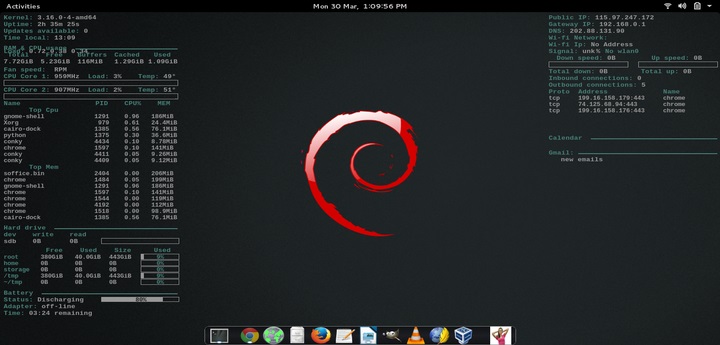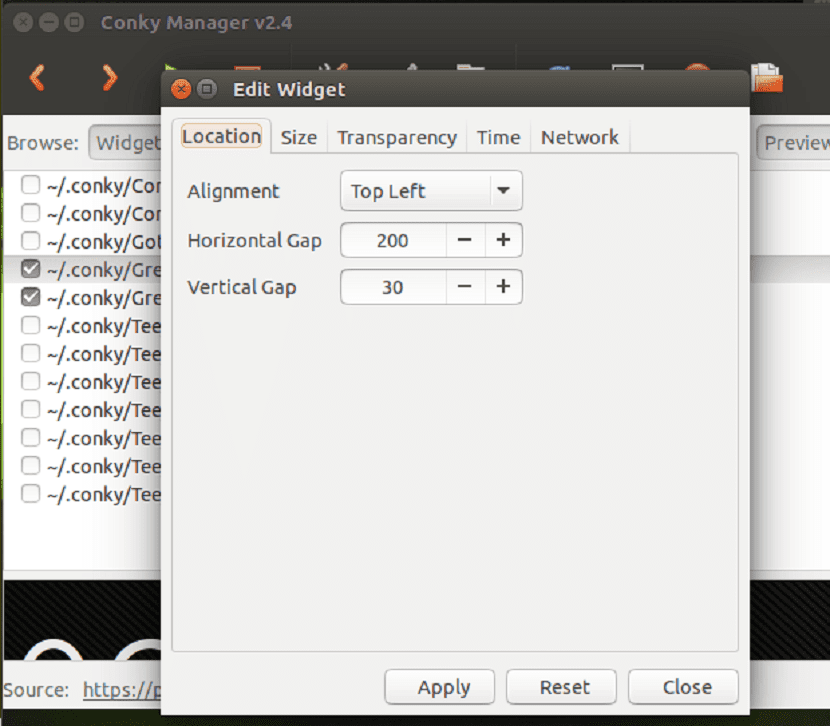This guide describes how to install and configure the system monitor known as Conky.
Background
Introduction to Conky
If you’re a customization buff and you don’t have Conky then you’re missing something. Install the Conky on Ubuntu via the terminal: $ sudo add-apt-repository ppa:teejee2008/ppa $ sudo apt-get update $ sudo apt-get install conky-manager 19. GDebi (Package Installer). So before installing any Conky theme, it acts according to the /etc/conky/conky.config file to show the default look. After downloading the archived theme file, extract it into your desktop. There will be a text file with some additional resources or even an installation manual.
So you have a Gentoo machine, and have already learned 30 different commands to monitor different aspects of what your computer is doing at the current moment. What do you do from here? Isn't there an easier way to monitor system performance and see what it's doing, as well as the resources it's using to perform all those tasks? This is what a system monitor, such as Conky, provides.
What it does
Unlike other system monitors such as top, Conky can run as a window in an X session, or by drawing to the root window (there is also an option to have Conky display information to stdout, but we won't discuss that here). It displays the information it has gathered through the use of both text, progress bars, and graphs. Also, unlike top, the way it is formatted is completely user-configurable. In addition to monitoring the system itself, Conky can also give you information about several music players (such as Music Player Daemon and Audacious Media Player), tell you how many new messages are in your mail spool, and plenty more. If the functionality you require isn't in Conky yet, it is a simple matter of writing a script to get the information you would like - some examples of this, which have already been done are RSS feeds, POP3 e-mail message count, local weather, boinc status, and even the status of Portage.
Installing Conky
Base install
Gentoo provides an ebuild to quickly and easily install Conky. Pay particular attention to the USE flags. You'll most likely want X11 support (X), and make sure you select the USE flags for any music players (other than MPD) which you want, such as Audacious (audacious). If you want to use the TCP port monitor, be SURE to disable the ipv6 use flag, as the port monitor is for IPv4 systems only.

In addition, the truetype USE flag compiles support for TrueType fonts with the use of Xft. Most users will want this as well.
You can add syntax highlighting for Conky's configuration file with the vim-syntax and nano-syntax USE flags, depending on your preferred editor.
root #echo app-admin/conky truetype audacious -ipv6 >> /etc/portage/package.useOnce you have your USE flags correctly set up, it's time to install Conky!
You can test Conky to see how it will look by running the command conky in a terminal. This will likely give you a good reference to how it will look and what you want to change, add or even remove.
Conky needs Double Buffer Extension (DBE) support from X server to prevent flickering, because it can't update window fast enough without it. It can be enabled in /etc/X11/xorg.conf with
Load 'dbe' line in Section 'Module'.Once you have an idea of how Conky looks, you can now move on to configuring it!
Configuring Conky
By default, Conky will look for a configuration file in the user's home directory located at ~/.conkyrc. This file contains all the configuration options, and the static text, colors and other variables which control what data is shown to the user. Conky also provides a great sample configuration, located at /etc/conky/conky.conf.
Now, open up the sample configuration in the text editor of your choice. You may notice that there are two separate sections of the configuration file. The first section of the file, contains the program configuration options and controls how it acts. This includes things such as the update_interval, or how often Conky will update the information on the screen. The second section contains the actual text, graphs, and variables which are rendered on the screen. This includes things such as the system uptime ($uptime), CPU usage ($cpu) and anything else you want to be shown. The first section of the file starts right from the beginning, the second section consists of everything after the line which says TEXT. Comments in the file start with #, but keep in mind that even if a line is commented out in the second section of the file, the text will still be rendered to the screen.
Lists of all the available configuration options and variables are kept at http://conky.sourceforge.net/config_settings.html and http://conky.sourceforge.net/variables.html . Besides, there are a few great screenshots along with sample configurations and scripts at http://conky.sourceforge.net/screenshots.html.
Extending Conky
Beyond the built-in variables
So you've gotten this far, and have scoured the Conky documentation for that extra variable which Conky just doesn't seem to have... You're in luck! Conky provides several variables for just this reason! $exec Will run a command every time Conky updates, $execi will run a command at a specified interval and $texeci will run a command in its own thread at a specified interval.
While any command which works in a command shell will work in any of these variables, it is important to keep in mind that the commands must exit. This means that commands like
tail -f which keep running will not work properly.This page is based on a document formerly found on our main website gentoo.org.
The following people contributed to the original document: Bill Woodford, Brenden Matthews, nightmorph
They are listed here because wiki history does not allow for any external attribution. If you edit the wiki article, please do not add yourself here; your contributions are recorded on each article's associated history page.
Project page: https://github.com/teejee2008/conky-manager


Conky Manager is a graphical front-end for managing Conky config files. It provides options to start/stop, browse and edit Conky themes installed on the system. Packages are currently available in Launchpad for Ubuntu and derivatives (Linux Mint, etc).
Features
- Start/Stop, Browse and Edit Conky themes
- Run Conky on system startup
- Options to change location, transparency and size of Conky widget window
- Options to change time and network interface
Screenshots
Themes
Most of the themes are from DeviantArt and the Eye Candy Linux community on Google+.
User Manual

A complementary user manual is now available for all users who have contributed to this project either through donations or by translating the application to other languages. The manual has a detailed description of the functionality along with steps required for creating theme packs and for fixing common issues.
If you wish to receive a copy of the user manual please consider leaving a donation using the PayPal link below. A copy will be sent to you by email. If you have already donated to this project you do not need to donate again.

Installation
Ubuntu-based Distributions (Ubuntu, Linux Mint, etc)
If you are using Ubuntu or its derivatives (like Xubuntu, Linux Mint, etc) you can install it from the Launchpad PPA. Builds are available for the following Ubuntu releases:
- 13.10 (saucy)
- 14.04 (trusty)
- 14.10 (utopic)
For any other release, you can install it using the DEB files given below.
Install Conky On Raspberry Pi
conky-manager-latest-i386.deb (32-bit, 1 MB)
conky-manager-latest-amd64.deb (64-bit, 1 MB)
To install from PPA, type the following commands one by one in a terminal window:
Updates will be installed automatically if you have enabled automatic updates enabled on your system. The package can also be updated manually by running the install command again.
Debian
The DEB files are available from following links:
conky-manager-latest-i386.deb (32-bit, 1 MB)
Conky Manager For Linux Mint
conky-manager-latest-amd64.deb (64-bit, 1 MB)
Disclaimer
This program is free for personal and commercial use and comes with absolutely no warranty. The author will not be liable for any damages arising from the use of this program.
This program is distributed in the hope that it will be useful, but WITHOUT ANY WARRANTY; without even the implied warranty of MERCHANTABILITY or FITNESS FOR A PARTICULAR PURPOSE.
See the GNU General Public License for more details.